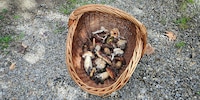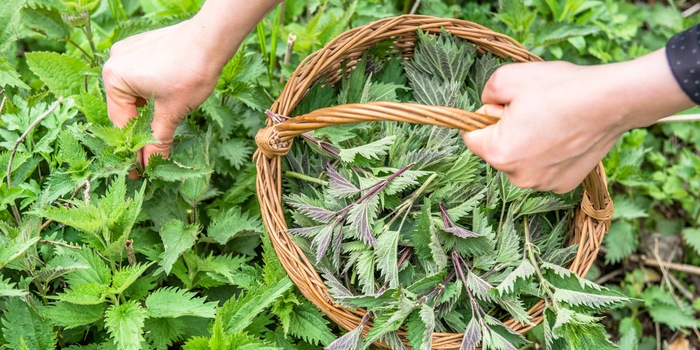
Background information
Why picking mushrooms with your family is fun, even without specialist knowledge
by Martin Rupf

Foraging for wild herbs in February is well worth it. These 5 plants are edible even before flowering in the spring – and taste fantastic.
In a way, they’re the plucky warriors of medicinal plants; those wild herbs staving off the February remnants of winter, green stalks stretching towards the sky as the rest of the natural world slumbers on. You can actually forage for medicinal plants all year round; it just depends on the species and the part of the plant you’re looking for. Evidently, it’s something more and more people are taking an interest in. Dr. Matthias Melzig, a professor at the Institute of Pharmacy at Freie Universität Berlin, says: «The green trend is gathering momentum, and I don’t just mean with regards to energy. Young people especially are asking themselves whether it’s always necessary to take antibiotics, or whether there are other remedies out there for mild ailments such as colds.» Particularly in these times of antibiotic resistance, i.e. an increasing number of pathogens becoming resistant to our synthetic antibiotics, medicinal plants are taking centre stage. Even in winter.
So, how soon can you start gathering edible wild herbs with medicinal properties in February? It depends on the region you live in. Wherever you are, Melzig has some advice, «Right at the beginning of the plant’s growth, there’s rarely much in the way of active ingredients, so you shouldn’t start too early.» However, if there’s no snow on the ground and the first shoots are starting to appear, there’s (almost) nothing to stop you going on the hunt for medicinal plants. The one thing to keep in mind is protecting the plants; don’t pick all the young shoots at once, otherwise that plant variety will cease to thrive.
Ingredients and effects: Chickweed contains vitamin C, flavonoids, saponins, coumarins and minerals. The zinc salts contained in the leaves of the herb support the immune system. Flavonoids fight off free radicals and have anti-inflammatory properties.
The phenolic acids contained in the herb are antimicrobial, which, Melzig says, are important for digestion: «There are many microorganisms that don’t belong in the microbiome. Phenolic acid curtails their ability to multiply.» This means the phenols in the plant promote digestion and protect the microbiome.
Traditionally, chickweed was used externally to treat haemorrhoids, skin infections and wounds. When ingested, it was used for bronchitis and rheumatism. «This is where the active ingredients’ anti-inflammatory properties come in, having a positive effect on the immune system,» says Melzig.
Where does the herb grow? Some bird species are fond of chickweed. They eat and spread the seeds, making it easy for the herb to propagate. It isn’t an especially large plant, and its leaves are small too. Unfortunately, many people think of it as more of a weed than a herb, as it covers entire swathes of ground. It’s mainly found in gardens, fields and vineyards, so generally in soil that’s rich with nitrogen and clay.
What to watch out for when foraging: According to Melzig, «If there are a lot of leaves on it and the plant is starting to flower, it has enough ingredients to be ready for picking. As long as it hasn’t started to flower, chickweed – like nettle, ground elder and ground ivy – is very palatable.
How do you prepare it? The tangy-mild, subtle taste of chickweed is supposedly reminiscent of corn on the cob. Melzig recommends adding it to a salad or even serving it as a vegetable.
Ingredients and effects: Ground ivy or glechoma has been used and valued as a medicinal plant for a long time, with its introduction to medicine primarily credited to Germanic tribes. It contains bitter substances, many phenolic compounds, flavonoids and triterpenes. Triterpenes have been used since ancient times to treat gastrointestinal illnesses.
Flavonoids can, as mentioned, keep inflammation in check. Ground ivy can be used for coughs and bronchial problems because the triterpenes improve the excretory function of the bronchi. In concrete terms, this means: «Triterpenes – and bitter substances – stimulate the glands’ secretion production, including within the bronchial tract, via the parasympathetic nervous system. As a result, thin bronchial secretion is produced in greater quantities, allowing the gunky mucous produced by a strong, chesty cough to be coughed up more easily. Ground ivy is also used as a diuretic i.e. a substance that promotes urine production.
Where does the herb grow? Ground ivy loves moist, clay-rich soil. It often grows along meadow edges, in pastures, in riparian forests, as vegetation near a body of water and on mountains up to 1,500 metres high. As a general rule, by the way: «The soil where ground ivy is found is generally in pretty good shape. Not contaminated much by pollutants, that is.»
What to watch out for when foraging: When ground ivy is still very young, it contains plenty of healthy bitter substances. However, the more the plant flowers, the more bitter it tastes. This isn’t a problem, as bitter substances aren’t bad for us per se – quite the opposite, in fact. Nevertheless, they can irritate the stomach if consumed in large quantities. It’s probably one of the reasons why bitter substances have been bred out of many crops and vegetable plants over the last few centuries. Firstly, though, bitter substances are important for our digestion. Secondly, it’s not like the plant produces them for fun – they do it to keep pests away too. If there are fewer bitter substances in the plant, more pesticides need to be used. Otherwise, predators such as birds and insects help themselves a little (too) greedily.
How do you prepare it? Given its high quantity of bitter substances, ground ivy is best used in salads, soups or savoury baked goods. It’s also a good idea to combine it with other herbs that don’t contain bitter substances, so that their flavour is softened a little.
Ingredients and effects: Ground elder, also known as goutweed contains essential oils, phenolic carboxylic acids, flavonoids, vitamin C and minerals. Its ingredients give it an excretory effect. As the plant’s name suggests, it was used in the past as a remedy for gout. Melzig says: «In treating gout, the goal is to flush out the uric acid triggering it by drinking a lot of fluids. Uric acid is poorly soluble in water, so the kidneys need to be constantly stimulated.» Ground elder can help with that.
Where does the herb grow? Moist soil with fewer nutrients, such as the earth found in ditches or streams, allows ground elder to thrive especially well. It’s less common in lowland areas, preferring elevations ranging from the foothills of the Alps to medium-sized mountain ranges around the 700-metre mark. These days, you don’t come across it all that often, as there have been frequent attempts to eradicate it on account of its invasiveness. Melzig says, «I have goutweed in my own garden that I’ve been trying to eradicate for 20 years, but all I’m managing to do is rein it in.» As for how he keeps the goutweed at a manageable level, he eats it along with the rhizome (an underground stem that grows horizontally, not to be confused with roots). After all, as Melzig points out, throwing it on the compost heap wouldn’t do much good – the herb would survive that. Bon appétit, I guess.
Please note when collecting: Goutweed tastes best before it flowers, so forage it as early as possible. And as Melzig recommends, «The goutweed rhizomes taste great. You can harvest them very early in the year.»
How do you prepare it? You can wash the rhizomes and eat them in a salad or cook them. The young leaves and stems are really good for making into a pesto. Smelling faintly of carrots, they also taste good fresh in a salad or prepared in the same way as spinach.
«There are a number of ways you can go wrong with lesser celandine. That’s because both pilewort and common scurvy grass are known as lesser celandine.» While scurvy grass is harmless to humans, pilewort (also known as fig butter cup) is only harmless before flowering. Once in bloom, it forms substances that can strongly irritate the mucous membranes, causing hypersensitivity and allergies.
The two plants can be distinguished by their flowers: scurvy grass flowers are white, whereas pilewort ones are yellow. For laypeople, the two plants are almost indistinguishable before flowering. Not that you’d need to work out the difference – they both have similar effects. However, as soon as the pilewort starts to flower, steer clear.
Ingredients and effect: Both herbs are very high in vitamin C. As its name suggests, scurvy grass was once used to treat vitamin C deficiency, especially in sailors. Among the general population, both plant varieties were used as diuretics for gout and rheumatism.
Where does the herb grow? Ficaria verna grows in moist and humus-rich clay soils, in riparian and deciduous forests. In parks, it often blankets large areas with bright yellow flowers. In the Alps, it can occasionally even be found in large quantities at elevations of up to 1,400 metres.
What to watch out for when foraging: Ficaria verna is one of the first wild herbs to bloom in the spring. With this in mind, once the leaves are fully formed, pick it as soon as possible. Melzig advises, «Please don’t forage lesser celandine if it’s developed an inflorescence (cluster of flowers). If the plant only has basal leaves (leaves appearing close to the soil surface), you’re good to go.» This is because once the wild herb begins to bloom, it’s no longer edible.
How do you prepare it? You can add lesser celandine (both varieties) to salads as a source of vitamin C.
Ingredients and effects: The leaves and, generally, every part of the plant above ground, contain phenolic ingredients, such as flavonoids, as well as trace elements, vitamin C and minerals. It also contains a large amount of potassium, which supports the kidney’s excretory function. This is why nettle leaves are commonly used as part of spring detox regimens. However, let’s not forget toxins don’t actually build up inside your body. Melzig says: «That’s a completely outdated idea based on Humorism, which has long since been revealed as an unscientific explanation for disease, and ditched.»
That being said, nettle leaves and their ingredients can stimulate the activity of the kidneys. Their bitter substances promote the secretory activity of the liver, improving digestion. Combined with a light meal, this can stimulate the metabolism.
Where does the herb grow? We all know what nettles look like and where they grow. Haven’t we all had painful run-in with their stinging hairs at some point?
What to watch out for when foraging: Pick the leaves and/or parts of the plant above ground before flowers start to form. This means the plant will contain more flavonoids, which have a diuretic effect. There are also more minerals, vitamin C and trace elements in the herb before it flowers.
How do you prepare it? Nettles don’t just taste good when they’re dried for use in tea. They’re also delicious fresh either as a vegetable or in soup. Their leaves are also fantastic in salads and smoothies.
The adjectives that describe me? Open-minded, pensive, curious, agnostic, solitude-loving, ironic and, of course, breathtaking.
Writing is my calling. I wrote fairytales age 8. «Supercool» song lyrics nobody ever got to hear age 15 and a travel blog in my mid-20s. Today, I’m dedicated to poems and writing the best articles of all time.
Interesting facts about products, behind-the-scenes looks at manufacturers and deep-dives on interesting people.
Show all